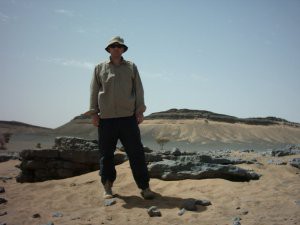 |
I took part in a 9 day desert survival course with Survival School in Morocco.The right clothing was essential.Here I wear a full length shirt and trousers by Rohan, and a broad brimmed floppy hat.
I also have my favourite sunglasses with leather sides, to keep out dust and sand. On my feet I wear British Army combat boots. |
| We slept out all but one night during the course.The first of the 2 sleeping systems I used, was a lifeventure free standing mosquito net. It didn’t need to be treated and worked perfectly.Inside I have my thermarest (I consider this to be the single best piece of outdoor gear I have ever purchased.) and my down sleeping bag, which in the desert, was unzipped and used as a 2nd mattress. |
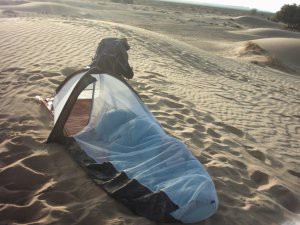 |
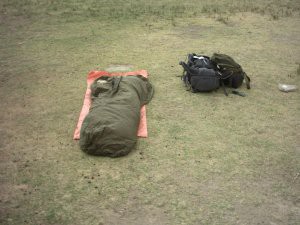 |
Whilst in mountains/forest etc, I used the same system, but substituted the mozzy net for a goretex bivvi bagI put an “orange” plastic bag underneath to protect my sleeping equipment. I normally carry one for emergency’s, sitting on to eat sandwiches etc, and they only cost £2.50One of my friends on the course Joe, showed me how to put my socks over the top of my boots, so that insects couldn’t get in. |
| Travelling in Land rovers, we arrive at our first camp, in the black desert.Our Berber drivers and guide make straight for a large tree. What use is that one tree in this enormous desert I wonder ?This proved to be the first of many lessons I would learn about survival/living in the desert. |
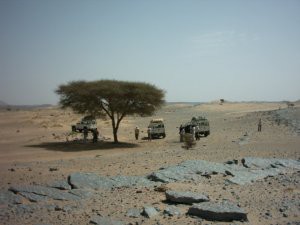 |
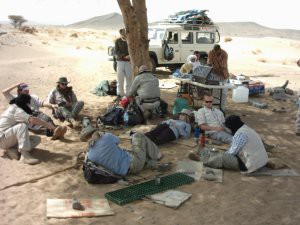 |
Between about 10:30am and 4:30pm, it is too hot to do anything. We woke most days at 6am, did our training until 10:30 and rested until the early evening, when we began our studies again.The tree was an invaluable resource, and as the shade moved throughout the day, the entire team moved with it! |
| Our instructor Kev, taught the first session on basic survival strategy.The 2nd session was about desert shelter construction.The first shelter we built was basically a large hole in the sand, with a basha covering the top, held in place with sand. |
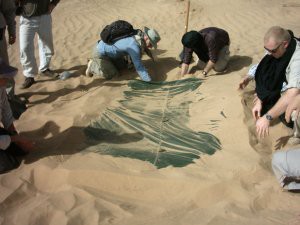 |
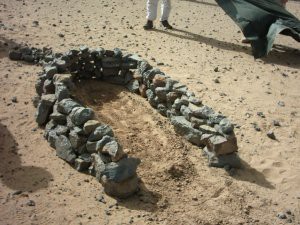 |
A better version off the shelter, was built above ground using rocks.The rocks are built into a u-shape with the sand inside removed to reveal the cooler sand underneath. |
| A 2nd smaller wall was built above this and another basha added.This double covering, created an air pocket which reduced the inside temperature of the shelter substantially. |
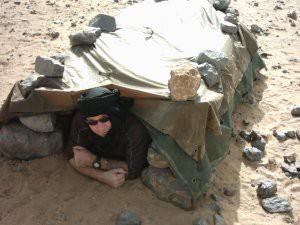 |
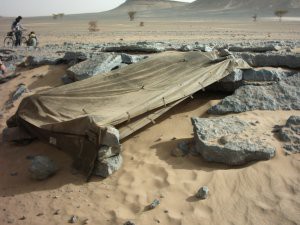 |
An improvised double layer shelter built near some rocks in the black desert by Mark and his wife Sylvie.If you look closely, in the top left hand corner of the picture, you can see a modern day Berber Nomad (hence the mountain bike) who had come over to see what we were doing. |
| Terry sits inside a classic double layer basha rig,set up at the front of a Land rover, with the vehicle providing a ready made backrest.The basha is supported by 2 sand ladders. |
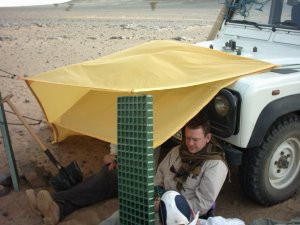 |
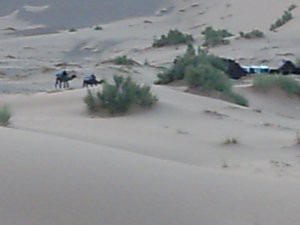 |
As we headed into the sand dunes, we came upon a Berber nomad camp.They live very simply in the desert, I was later to find just how hard their lives must be, when I spent 5 days in the dunes. |
| Our guide Mohamed was a chef and restaurateur, who cooked us restaurant quality food, in the middle of the desert each night.This proved invaluable towards moral, since although the course was well organized, and the participants a great bunch, you cant beat a good meal.Here, Lamb is spit roasted by the fire. |
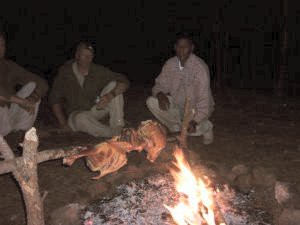 |
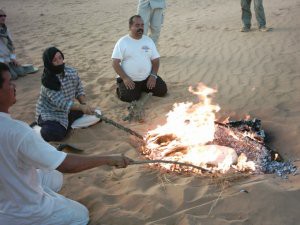 |
A few of us, wanted to see how bread is cooked traditionally by the Berber Nomads.Our guides went to a nomad village, and negotiated for someone to come and demonstrate.A local Berber woman arrived and took charge of the fire. |
| We were all fascinated by her bread making, and although a proud woman, she seemed delighted at all the attention she received.The doe is prepared, then placed on a smooth bed of sand, coated with a slight layer of sand, then covered over with embers.The end product, perfect crispy bread, cooked on an open fire. |
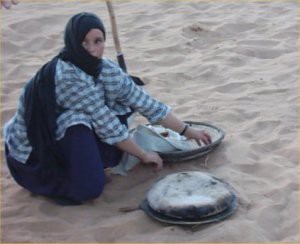 |
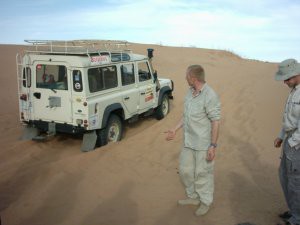 |
Kev gives a talk on vehicle recovery, using one of the 3 Land rovers we had at our disposal.The course did not cover off road driving, as this would require an entire course, devoted solely to that subjectWe were taught several different ways of getting vehicles out of trouble, including the simple yet amazingly effective “trick” of letting the tyres down slightly. |
| Here we use sand ladders to retrieve our trusted “landy”.The session continued with a talk on selection of vehicle, and what equipment should be carried, avoidance of overloading the roof rack etc. |
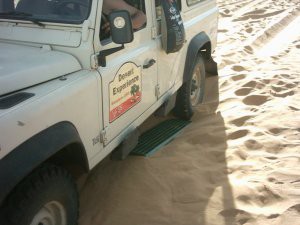 |
 |
Some of the strange creatures we encountered.This is a scorpion which we found.We also saw a beetle, which Mark (who worked at London Zoo) identified as having the strongest jaw bone in the animal kingdom. |
| Whilst doing night navigation, John Mallet discovered this Sand Viper.We were all perfectly fine, as we were wearing boots.I couldn’t go too near it with the camera though, so I have had to enhance this picture a little. |
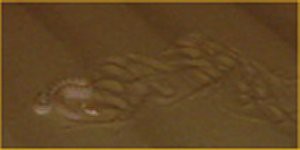 |
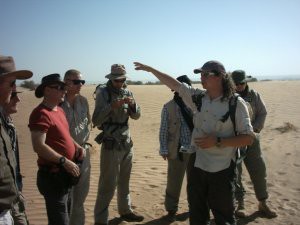 |
JK leads the session on navigation using compass.We used several different types of compass on the exercise, which covered fundamentals, but also emphasised practical use in the desert.This was complimented by the previous evenings talk on finding latitude and longitude using simple tools, and navigation from the stars. |
| After this, we did a sat nav exercise.On my wrist I am wearing my Garmin Sat Nav which I have owned for some time. Like many things, I had never actually used it before, but JK taught me all sorts of tricks with it.One off my favourite things was using it when travelling in vehicles. Its possible for example to use the GPS to calculate time/distance from destination and use it on trains and buses. |
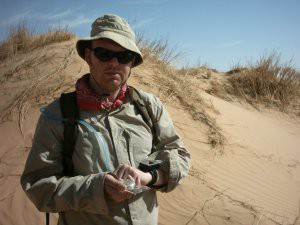 |
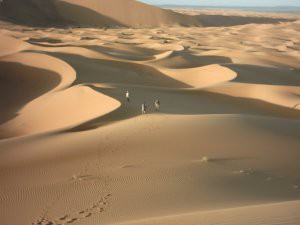 |
The next day, we had a navigation exercise, where we were tested on our navigation and got to practice travelling across the tops of sand dunes (its useless walking up and down them, as its wastes energy). |
| One of the session was on firelighting.Here a bucket is filled with a mixture of sand and fuel, with the sand acting as a wick.Its a simple controlled way of lighting a fire in the desert. |
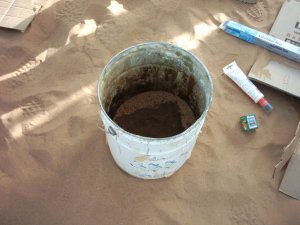 |
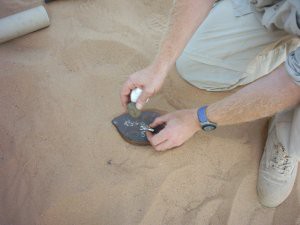 |
Here, Kev takes a bulb he has, and breaks the glass around it. |
| Next one of our drivers, removes the cover and replaces the bulbs. |
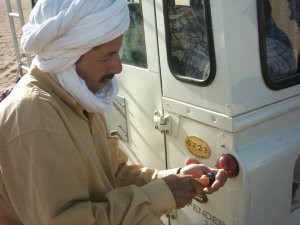 |
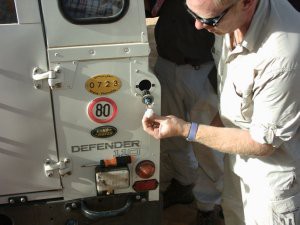 |
With the light activated, Kevs “broken” bulb lights some cotton wool from the first aid kit. |
| It’s often Anecdotally stated that you can make fire from coca cola and chocolate.The basic idea, is that the bottom of the coke can, can be polished with the chocolate, and then used as a kind of Lens, to focus sunlight onto some tinder. |
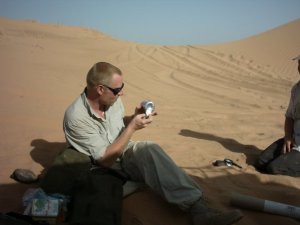 |
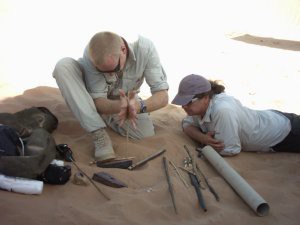 |
Kev and JK demonstrate firefighting with a firedrill.I have tried fire drill before and always found it very difficult.I imagined using one in somewhere like Africa, would be much easier. It wasn’t. |
| As a fun evening project, we had plans for a solar cooker, printed from the Internet, and various blue peter type resources to build one.I promoted myself to project manager, but by the time I had organized meetings, drawn a gant chart and arranged finance for the project, the lads had actually built it. |
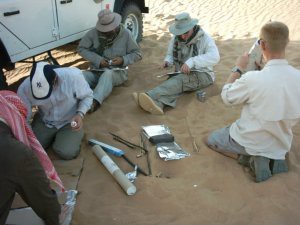 |
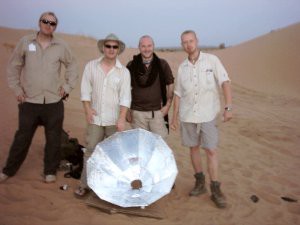 |
The finished solar cooker.The basic idea, is that several triangular pieces of cardboard, have tinfoil glued to them, and are then fastened together. To form a find of satellite dish.A metal container with food (in our case, rice) is placed in the centre, and the whole thing is moved around to face the sun.
In 2 hours, it cooked the rice perfectly. |
| Next was a session on water procurement.Pat and I purify some water, with the new filter, which I had bought for the trip. |
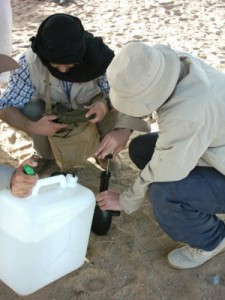 |
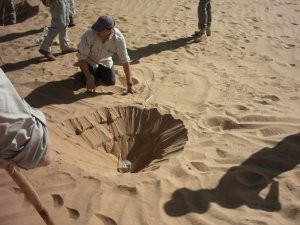 |
JK prepares a solar still.A container is placed at the bottom, with a length of plastic pipe fed through the sandIf you don’t do it this way you have to dismantle the still every time you want to drink the water. |
| Next its covered over with a polythene sheet, and a stone is placed on the plastic, so the condensation, drips into the container.We made one with urine, dirty water and foliage, and one with just sand. |
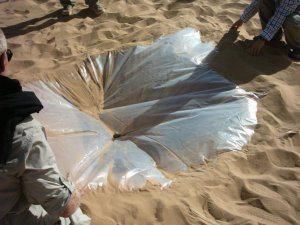 |
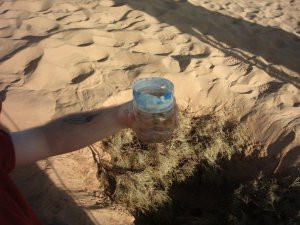 |
The solar still with the foliage etc, produced this (a third of a litre).The water was brown and stank (but we were in a desert, and it was still water !).The solar still with just sand, produced nothing. |
| A plastic bag, placed around some foliage.Produced 3 times as much water as the successful solar still, and required no-where near the effort to create. |
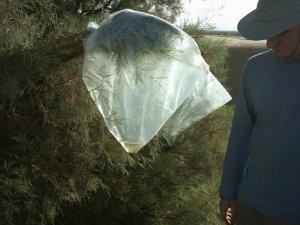 |
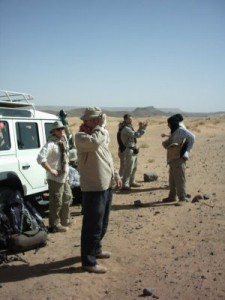 |
We did a session on signalling.It became obvious, almost immediately, that a signalling mirror, is the weapon of choice in the daytime, and 3 fires were the best option at night.Here I practice with different sorts of mirrors, including cd’s. |
| This Land rover is a quarter of a mile away, and can hardly be seen (hence the red circle around itIts for this reason, that the advice to stay with the vehicle is normally given. A person standing next to the land rover, can hardly be seen.This was one of the best trips, that I have ever done, I would like to thank everyone at Survival school and all the people that took part. |
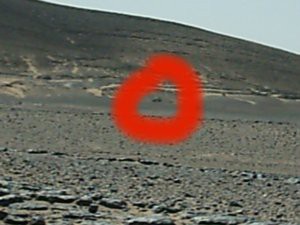 |
Hi, May I ask where you booked this?
Sorry for Delay
It was Survival School, run by Jonny Crocket.
Thanks
John